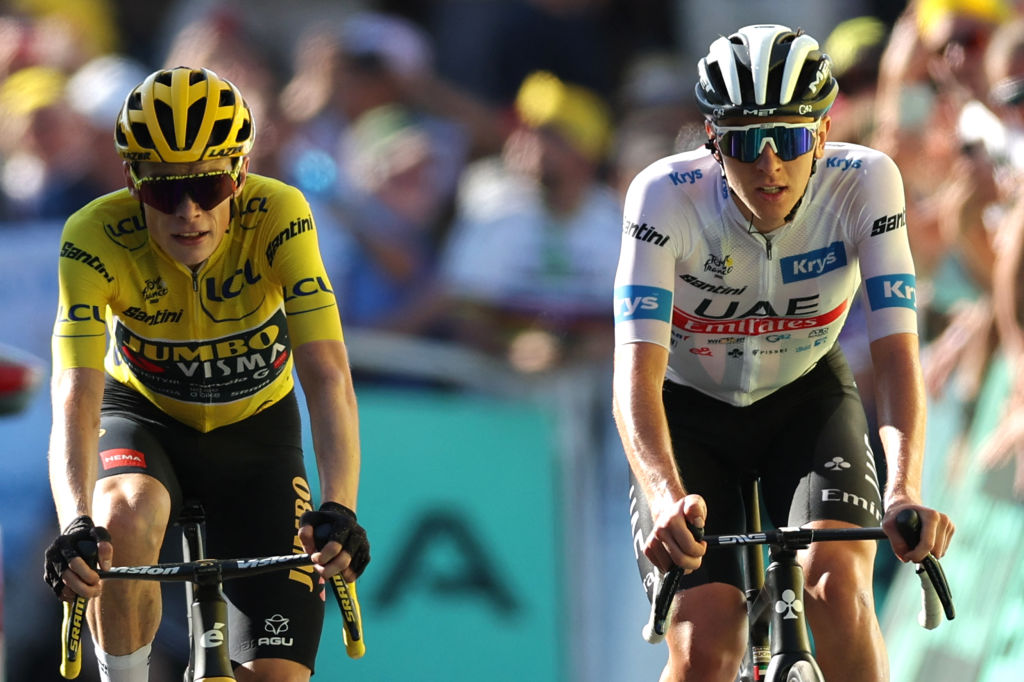
The Tour de France can be one of the most closely contested races in the entire sport of cycling or it can be a massive blow-out. What happens in the unlikely event the race ends with two or more riders finishing the race in the exact same amount of time?
Last year, until the stage 16 time trial, the margin between defending champion Jonas Vingegaard (Jumbo-Visma) and two-time Tour winner Tadej Pogačar (UAE Team Emirates) was so tight that most of the difference came from the time bonuses.
While the Tour de France ended in a blowout when Pogačar cracked in the final week, there have been years when the race is decided by seconds. Eight seconds is the current record for the closest Tour de France in the famous race between Greg LeMond and Laurent Fignon.
Can the Tour de France end in a tie?
The Tour de France has three ways of breaking a tie that guarantees the race will never end in a tie.
The official rules state: In the event of a tie in the general classification, the hundredths of a second recorded by the timekeepers during the individual time trial stage will be included in the total times in order to decide the overall winner.
The rule means that the Tour de France could be won by as little as 0.01 seconds.
In the unlikely event that riders finish the Tour in the exact same time or, if the race doesn't include a time trial, then the judges add up all of the rider's stage placings and the rider with the smallest number is declared the winner.
If the riders mathematically remain tied on stage results, then the positions in which they finished each stage will be added up and, as a last resort, their finishing position on the final stage will be taken into account.
There is an infinitesimally small chance of riders ending the final stage in a sprint that cannot be decided by the high-speed cameras but the rules do not take this into account.
Points classification tie breakers
The rules for the points classification take into account the chance of a dead heat on a stage. The points for the tied positions are added up and distributed equally to each rider involved in the tie, to the nearest 1/2 point.
A more likely scenario is riders finishing the Tour de France with the exact same number of points. The closest points classification to date was the 2003 Tour de France where Baden Cooke beat fellow Australian Robbie McEwen by just two points.
If riders are equal on points in this classification, they are separated by their number of stage wins and then by their number of wins in the intermediate sprints that count towards the points classification, and, finally, by their ranking in the general classification.
Mountains classification tie breakers
In the mountains classification, ties are broken by the riders' placing on the most difficult climbs.
So, the rider with the most first places at the summit of above-category climbs would be the winner. If they are still tied, it would fall to category 1, then category 2 and then categories 3 then 4.
As a last resort, the rider with the best placing in the general classification would be the mountains classification winner.
Teams classification tie breakers
The best team of the Tour de France is decided by the total time of each team's best three riders on each stage.
If there is a tie between teams in the stage rankings, the three highest places achieved by each team’s riders on that stage are added together. In the event of a further tie, the teams are split by the finishing position of their highest-placed rider on the stage.
The team leading the teams classification wear a yellow helmet and bib number.
The best team of the Tour de France is decided by the lowest overall time in the teams classification.
If there is a tie, teams are separated by adding up the number of stage victories per team, then by the number of second places, and so on, until the number of places obtained by one team enables a definitive ranking to be established.
If there is still a tie, teams will be split by the positions of their highest-placed rider in the general individual classification.







